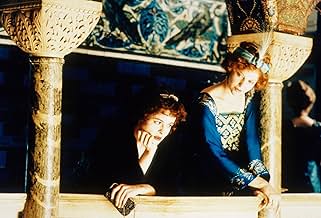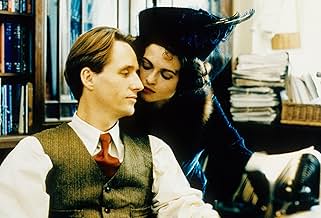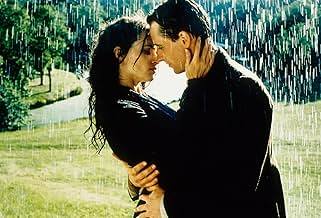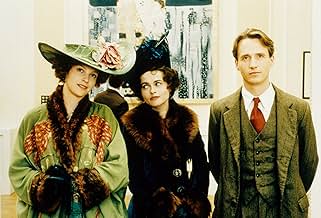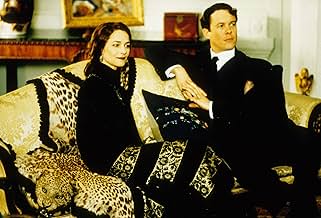CALIFICACIÓN DE IMDb
7.1/10
13 k
TU CALIFICACIÓN
Una mujer obligada a elegir entre una vida privilegiada y su amante periodista, entabla amistad con una heredera. Cuando descubre que la heredera está atraída por su propio amante y se está ... Leer todoUna mujer obligada a elegir entre una vida privilegiada y su amante periodista, entabla amistad con una heredera. Cuando descubre que la heredera está atraída por su propio amante y se está muriendo, ve la oportunidad de tener ambas vidas.Una mujer obligada a elegir entre una vida privilegiada y su amante periodista, entabla amistad con una heredera. Cuando descubre que la heredera está atraída por su propio amante y se está muriendo, ve la oportunidad de tener ambas vidas.
- Dirección
- Guionistas
- Elenco
- Nominado a 4 premios Óscar
- 16 premios ganados y 32 nominaciones en total
Mark Chapman
- Royal Bodyguard
- (sin créditos)
Gary Condés
- Man in Boat Queue
- (sin créditos)
Royston Munt
- Carriage Driver
- (sin créditos)
Guy Standeven
- Man in Bookshop
- (sin créditos)
- Dirección
- Guionistas
- Todo el elenco y el equipo
- Producción, taquilla y más en IMDbPro
Opiniones destacadas
"The Wings of the Dove" poetically unveils itself with beautiful visuals and explorations in to the complexities of desire. A tragic irony, with an excellent finale. This movie also contains the most painfully emotive sex scene that I have ever seen; as it is honest and detailed with emotions that so rarely are captured this brilliantly in 'art'. This movie is intimate.
It is London in 1910 and protagonist Kate Croy, a beautiful young woman, is living with her wealthy but controlling aunt. Kate has fallen in love with Merton Densher, a journalist of whom her aunt disapproves and forbids her to see. Her aunt is pushing her in the direction of the 'more suitable' Lord Mark. When wealthy young American heiress Milly Theale arrives on the scene Lord Mark informs Kate that Milly is dying and he intends to marry her for her money, to save his estates, before returning to Kate... Kate decides Merton should be the one getting close to Milly so, during an extended holiday in Venice guides them together... there is a risk though; what if he falls in love with her?
I've not read the book on which this film is based so can't say how they compare; but as a work in its own right I really enjoyed it. The romance feels real, with Kate clearly knowing she is taking a risk... both that her aunt will disinherit her for seeing Merton and that he might genuinely fall for Milly. The setting is beautifully realised but never feels dated... which it shouldn't as whatever present one is in feels modern for those people in it. Helena Bonham Carter does a brilliant job in the role of Kate; she shows what Kate is feeling with the subtlest of expressions; she also makes it easy to sympathise with Kate even while she is being morally ambiguous. Linus Roache and Alison Elliott impress as Merton and Milly respectively and the rest of the cast is solid. The film looks great from start to finish as it moves from London to Venice. Overall I'd definitely recommend this to fans of period dramas.
I've not read the book on which this film is based so can't say how they compare; but as a work in its own right I really enjoyed it. The romance feels real, with Kate clearly knowing she is taking a risk... both that her aunt will disinherit her for seeing Merton and that he might genuinely fall for Milly. The setting is beautifully realised but never feels dated... which it shouldn't as whatever present one is in feels modern for those people in it. Helena Bonham Carter does a brilliant job in the role of Kate; she shows what Kate is feeling with the subtlest of expressions; she also makes it easy to sympathise with Kate even while she is being morally ambiguous. Linus Roache and Alison Elliott impress as Merton and Milly respectively and the rest of the cast is solid. The film looks great from start to finish as it moves from London to Venice. Overall I'd definitely recommend this to fans of period dramas.
The Wings of the Dove (1997)
Yes, this is a quite, indirect, thoughtful movie. But it is never slow. And the acting is incredible, almost as incredible as all the dresses and interior sets, which will blow anyone's mind. The story, by Henry James (the master of indirect but probing feelings), is about love of all kinds. And about being a good person, really. Three of the four main leads struggle with doing the right thing (and they do the right thing). The fourth struggles, falters, then comes forward again, then falters, finally, by making a demand that can never be met.
It's unfair to compare this kind of period movie (set around 1910 even though James's book was published in 1902) to "A Room with a View" (set in the same decade) but the reason this happens is that the 1985 Merchant-Ivory masterpiece seemed to open up a new way of making period films, filled with beauty and lingering thoughts and, well, feeling. Not the feeling two people have for each other, but a feeling of a time and place. It so happens the star of this 1997 film, Helena Bonham Carter, also starred (magnificently) in the first one.
The other star is a man, Linus Roache, who almost overplays his understated character by making him dry and deadpan and polite. But it works, over time, to help make the final few seconds of the film (which are so important) succeed. The third lead, really, in this lopsided triangle, is Alison Elliott, who puts in an equally subtle performance. So much of the movie is about little changes in facial expression, the acting had to rise to the needs of the plot. Bonham Carter, above all, does this with chilling perfection.
But those dresses! This is what is called Edwardian England, the first decade of the 20th Century, a time when modernity swept Europe with a passion (Picasso and Klimt) and when cars and other new technologies were surging. The styles of the dresses are part Art Nouveau, with its Asian influences, and part European excess, a showing off of style and wealth and material sensibility. Thank god! It's just breathtaking. The interiors are likewise brimming with tiles and flowers and paintings and light of all kinds.
All of this is handled with a cinematic control that reminds me of the color coordination of mid-century Technicolor films, where the palette of a scene is often limited to a pair of colors. You'll see many scenes where a mix of blue and rusty orange are the only two colors in various guises (and these are most common because of the hair and eyes of Elliott). The cinematography is by Eduardo Serra, one of a handful of the most sumptuous contemporary shooters in film ("Girl with the Pearl Earring" and "What Dreams May Come"). And he lets the light and color inhabit every scene, never letting the photography get in the way. Just beautiful.
So what does it mean to be a good person? Who cares with all this great acting and beautiful filming? But really, you do care, and it's a touching and provoking film in all its quietness. And it's not a bit obscure. Henry James never quite liked the book, but I think it's because he expected more from it, the themes and characters are so promising. Critics have come to see it as one of his great late novels, and that much is here. Director Iain Softley takes a couple of turns that the book avoids--a little sensational talk toward the beginning, and a frank and sex scene at the end--and both are okay in the film but not actually in keeping with the tone of the rest of it, which is about never quite showing your hand even to your closest friends. It's about waiting to speak, and hiding even good intentions for fear of seeming good when in fact part of being good is simply being good, not merely seeming it.
Yes, this is a quite, indirect, thoughtful movie. But it is never slow. And the acting is incredible, almost as incredible as all the dresses and interior sets, which will blow anyone's mind. The story, by Henry James (the master of indirect but probing feelings), is about love of all kinds. And about being a good person, really. Three of the four main leads struggle with doing the right thing (and they do the right thing). The fourth struggles, falters, then comes forward again, then falters, finally, by making a demand that can never be met.
It's unfair to compare this kind of period movie (set around 1910 even though James's book was published in 1902) to "A Room with a View" (set in the same decade) but the reason this happens is that the 1985 Merchant-Ivory masterpiece seemed to open up a new way of making period films, filled with beauty and lingering thoughts and, well, feeling. Not the feeling two people have for each other, but a feeling of a time and place. It so happens the star of this 1997 film, Helena Bonham Carter, also starred (magnificently) in the first one.
The other star is a man, Linus Roache, who almost overplays his understated character by making him dry and deadpan and polite. But it works, over time, to help make the final few seconds of the film (which are so important) succeed. The third lead, really, in this lopsided triangle, is Alison Elliott, who puts in an equally subtle performance. So much of the movie is about little changes in facial expression, the acting had to rise to the needs of the plot. Bonham Carter, above all, does this with chilling perfection.
But those dresses! This is what is called Edwardian England, the first decade of the 20th Century, a time when modernity swept Europe with a passion (Picasso and Klimt) and when cars and other new technologies were surging. The styles of the dresses are part Art Nouveau, with its Asian influences, and part European excess, a showing off of style and wealth and material sensibility. Thank god! It's just breathtaking. The interiors are likewise brimming with tiles and flowers and paintings and light of all kinds.
All of this is handled with a cinematic control that reminds me of the color coordination of mid-century Technicolor films, where the palette of a scene is often limited to a pair of colors. You'll see many scenes where a mix of blue and rusty orange are the only two colors in various guises (and these are most common because of the hair and eyes of Elliott). The cinematography is by Eduardo Serra, one of a handful of the most sumptuous contemporary shooters in film ("Girl with the Pearl Earring" and "What Dreams May Come"). And he lets the light and color inhabit every scene, never letting the photography get in the way. Just beautiful.
So what does it mean to be a good person? Who cares with all this great acting and beautiful filming? But really, you do care, and it's a touching and provoking film in all its quietness. And it's not a bit obscure. Henry James never quite liked the book, but I think it's because he expected more from it, the themes and characters are so promising. Critics have come to see it as one of his great late novels, and that much is here. Director Iain Softley takes a couple of turns that the book avoids--a little sensational talk toward the beginning, and a frank and sex scene at the end--and both are okay in the film but not actually in keeping with the tone of the rest of it, which is about never quite showing your hand even to your closest friends. It's about waiting to speak, and hiding even good intentions for fear of seeming good when in fact part of being good is simply being good, not merely seeming it.
This was not one of my favorite novels when I read it (for James, I prefer THE PORTRAIT OF A LADY), but this is a very good film. Director Iain Softley and writer Hossein Amini made the smart decision to move this up in time to the 1910's, which enables them to get to the passions more than James does here. Softley also makes this darker than most literary adaptations, in look and in tone, without suffocating it, and he avoids making this a film about production design rather than about a story. He does labor a bit in trying for tragedy, but that's only a quibble.
Alison Elliot, a good actress (I liked her in THE UNDERNEATH and the otherwise flawed THE SPITFIRE GRILL), takes awhile to warm up as Millie, because she seems a little too modern, but she avoids easy sentiment as the dying heiress. Linus Roache, who I thought was a little awkward in PRIEST, here avoids the trap of being the third wheel, making us understand what both Millie and Kate see in Merton. But the real triumph here is Helena Bonham Carter, who gave the best performance of the year. One character says of Kate, "There's something going on behind those beautiful lashes," and that can usually be said of the characters Carter plays, but sometimes she's overly detached. Here, she's completely engaged, and she pulls off the difficult trick of never losing our sympathies even when her character does something despicable. And where James sort of made Kate just manipulative, Carter makes her human and longing.
Alison Elliot, a good actress (I liked her in THE UNDERNEATH and the otherwise flawed THE SPITFIRE GRILL), takes awhile to warm up as Millie, because she seems a little too modern, but she avoids easy sentiment as the dying heiress. Linus Roache, who I thought was a little awkward in PRIEST, here avoids the trap of being the third wheel, making us understand what both Millie and Kate see in Merton. But the real triumph here is Helena Bonham Carter, who gave the best performance of the year. One character says of Kate, "There's something going on behind those beautiful lashes," and that can usually be said of the characters Carter plays, but sometimes she's overly detached. Here, she's completely engaged, and she pulls off the difficult trick of never losing our sympathies even when her character does something despicable. And where James sort of made Kate just manipulative, Carter makes her human and longing.
I can't believe there are only two comments for this film. It's a subtle film and a rare one in which your feelings for the characters change. I have read the book, and seen all the other films made of Henry James novels, and this one is by far the best at translating at least some of the moral ambiguity at the heart of most James novels.
Helena plays a woman forced to give up her boyfriend Merton because he has no money. She meets and befriends a wealthy, but terminally ill American, Milly. She decides that Merton will court Milly, inherit all of Milly's money when she dies, and have the funds to marry Helena. The film is about Merton's moral awakening as he realizes how horrible what he's doing is, and WHO Helena's character really is.
You would have to read the novel to understand how difficult it is to adapt this material, and what a great job they really have done. Bring your hankies for the scene near the end (not in the novel, actually) in which Merton apologizes to Milly. This invented scene crystallizes all of the emotion and makes the movie fulfilling in a way a straight working of the novel could not have been.
Helena is good, but her character is simplified somewhat from the book. I think this should have at least been up for Best Picture. See it.
--- Check out website devoted to bad and cheesy movies: www.cinemademerde.com
Helena plays a woman forced to give up her boyfriend Merton because he has no money. She meets and befriends a wealthy, but terminally ill American, Milly. She decides that Merton will court Milly, inherit all of Milly's money when she dies, and have the funds to marry Helena. The film is about Merton's moral awakening as he realizes how horrible what he's doing is, and WHO Helena's character really is.
You would have to read the novel to understand how difficult it is to adapt this material, and what a great job they really have done. Bring your hankies for the scene near the end (not in the novel, actually) in which Merton apologizes to Milly. This invented scene crystallizes all of the emotion and makes the movie fulfilling in a way a straight working of the novel could not have been.
Helena is good, but her character is simplified somewhat from the book. I think this should have at least been up for Best Picture. See it.
--- Check out website devoted to bad and cheesy movies: www.cinemademerde.com
¿Sabías que…?
- TriviaThe original Milly was a tribute to Henry James' niece Minny, who died of tuberculosis.
- ErroresThe tile pattern on the Underground stations the train passes through at the beginning of the film are identical in pattern and color for each station. Each station on the Piccadilly line had its own tile pattern and color scheme so that the illiterate could still recognize their station without needing to read the station name.
- ConexionesFeatured in Venice Report (1997)
Selecciones populares
Inicia sesión para calificar y agrega a la lista de videos para obtener recomendaciones personalizadas
- How long is The Wings of the Dove?Con tecnología de Alexa
Detalles
- Fecha de lanzamiento
- Países de origen
- Sitio oficial
- Idioma
- También se conoce como
- The Wings of the Dove
- Locaciones de filmación
- 10 Carlton House Terrace, St. James's, Londres, Inglaterra, Reino Unido(Aunt Maud's house, interior and exterior)
- Productoras
- Ver más créditos de la compañía en IMDbPro
Taquilla
- Total en EE. UU. y Canadá
- USD 13,692,848
- Fin de semana de estreno en EE. UU. y Canadá
- USD 183,610
- 9 nov 1997
- Total a nivel mundial
- USD 13,692,848
- Tiempo de ejecución1 hora 42 minutos
- Mezcla de sonido
- Relación de aspecto
- 2.35 : 1
Contribuir a esta página
Sugiere una edición o agrega el contenido que falta

Principales brechas de datos
By what name was Las alas de la paloma (1997) officially released in India in English?
Responda


